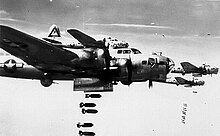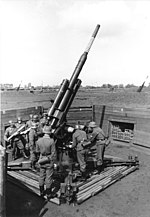Air raids on the Buna plant in Schkopau
The Buna plant in Schkopau near Merseburg has been producing synthetic rubber since 1937 . It was attacked five times during World War II from July 28, 1944 to December 12, 1944 by heavy bombers of the 8th Air Force escorted by long-range fighters. A total of 741 bombs detonated: 208 bombs on the factory premises, 179 bombs on the waterworks premises and 354 more bombs in the vicinity (including the town of Schkopau). The material damage to the plant was estimated at over 10 million Reichsmarks . The consequences for production were considerable.
The work
The Buna plant was the world's first synthetic rubber plant. It was a subsidiary of the ammonia plant in Merseburg and belonged to the IG Farben group. It was built from 1936 to 1944 and, in addition to rubber for civil and military purposes, produced a wide range of chemical products. In 1943 67,700 tons and in 1944 46,000 tons of synthetic rubber were produced. The following were also produced: polyvinyl chloride (PVC), fuels ( using the hydrogenation process ), trichlorethylene , formaldehyde , tetrahydrofuran , vinegar , acetic anhydride and acetone .
In 1944 the plant had around 11,000 employees, including 6,000 foreign workers - most of them Italian military internees and " Eastern workers ".
Air defense and air defense
Schkopau and the Buna factory were located in the area of the central German anti-aircraft belt , which has been considerably strengthened since the start of the Allied fuel offensive on May 12, 1944. One of the four flak departments was at "Schkopau West". The flak had guns with the calibers 8.8 cm, 10.5 cm and 12.8 cm. In addition to this “heavy” flak, feared by the bomber crews, the large factories themselves had “light” 2 and 3 cm flak. Such guns were stationed in the Buna plant on the roofs of three power plants and a carbol factory . After the first bomb hits on the plant in July 1944, air protection measures at the plant were intensified. Four bunkers were ready by September 1944 (and thus before the main attacks). The high bunker I 4 was also available to the population of Schkopau, Korbetha and Freienfelde . Cylindrical one-man concrete bunkers were set up in the production facilities for the emergency crews .
The individual attacks
All attacks mentioned here were carried out by B-17 “Flying Fortress” of the 8th Air Force of the USAAF as daytime attacks as part of large-scale operations against targets in central Germany , especially against the “chemical region” of Merseburg, Leuna, Lützkendorf and Schkopau. The bombers were accompanied by a similar number of fighters / fighter bombers . Their bases were in England . A total of 741 high-explosive bombs detonated in and around the company premises. The attack on July 28th was not planned on the Buna plant, but the attacks in November and December are expected to be targeted at the plant: on the synthetic rubber and polyvinyl chloride manufacturing plants , their tank farms and the rubber shipping warehouse.



- July 28, 1944: 651 Boeing B-17s launched a major attack on the ammonia plant in Merseburg near Leuna . This was the first time they came across the newly developed German Me 163 B missile fighters , which were 250 km / h faster than the US escort fighters. There was considerable confusion in the American federation, which resulted in the left wing of the attacking bombers deviating northward from the course, releasing its bomb load. The carpet of bombs hit particularly the Lauchagrund , the Merseburg district of Freimfelde and the area up to the southern edge of the Buna factory. The following were hit there: the intermediate product tank farm A 19, the factory bathroom, the waterworks (outside the factory premises) and some other objects were slightly damaged. The property damage was estimated at 858,000 Reichsmarks.
- Were taken in the attack again the storage tank A 19: 21 November 1944 PVC -E- polymerization A 44, the Buna polymerization B 39, the butadiene -Tanklager A 39 / A 39a and the phthalic acid - distillation D 32 and other Objects. The damage was estimated at 3.843 million RM.
- November 25, 1944: Met were the carbide oven 6, chlorine complexes , the large acetylene - Gasometer I 40 and many other objects. The property damage amounted to 4 million RM.
- December 6, 1944: The rubber dispatch warehouse D 52 and the factory for rubber polymerization auxiliaries D 59 were hit. The damage was estimated at 1.146 million RM.
- December 12, 1944: Again the waterworks was hit and destroyed, mainly the filter construction W 2: thus the service water supply of the works. Damage: 375,000 RM.
The distribution of the bomb detonations
- Buna factory premises: 208 bombs
- Waterworks site: 179 bombs
- Area between Freiimfelde and the Buna factory fence: 272 bombs
- Schkopau to Kollenbeyer Holz: 82 bombs
There were also numerous duds .
The property damage
The material damage in the Buna plant in Schkopau was considerable and was estimated at 10.177 million RM. The damage was repeatedly repaired as far as possible, but the production of rubber and other products at the plant declined significantly. The amount of 67,700 tons of rubber in 1943 fell to 46,250 in 1944.
After the occupation
The plant was closed on April 12, 1945. On April 14, US troops occupied the Buna plant in Schkopau. They took 25 scientists (including Wilhelm Biedenkopf ) and technicians, as well as all the important technical documents, process descriptions, documentation, patents and precious metals with them into their zone of occupation as spoils of war. From July 1, 1945, the plant and the region were handed over to the Red Army .
literature
- Roger A. Freeman: Mighty Eighth War Diary . JANE's. London, New York, Sydney 1981. ISBN 0-7106-0038-0 .
- Olaf Groehler : bombing war against Germany . Akademie-Verlag, Berlin 1990. ISBN 3-05-000612-9 . P. 341.
- Heinz Rehmann: The Anglo-American bomb attacks during the Second World War on targets in the Merseburg area and the German defensive measures . In: Merseburg contributions to the history of the chemical industry in Central Germany. Ed .: Material witnesses of the chemical industry e. V. Merseburg 2002. pp. 40-46.
